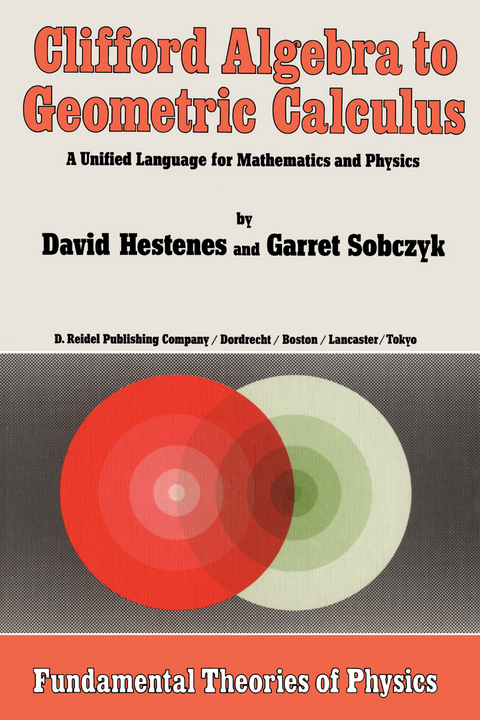
Clifford Algebra to Geometric Calculus
Kluwer Academic Publishers (Verlag)
978-90-277-1673-6 (ISBN)
Matrix algebra has been called "the arithmetic of higher mathematics" [Be]. We think the basis for a better arithmetic has long been available, but its versatility has hardly been appreciated, and it has not yet been integrated into the mainstream of mathematics. We refer to the system commonly called 'Clifford Algebra', though we prefer the name 'Geometric Algebm' suggested by Clifford himself. Many distinct algebraic systems have been adapted or developed to express geometric relations and describe geometric structures. Especially notable are those algebras which have been used for this purpose in physics, in particular, the system of complex numbers, the quatemions, matrix algebra, vector, tensor and spinor algebras and the algebra of differential forms. Each of these geometric algebras has some significant advantage over the others in certain applications, so no one of them provides an adequate algebraic structure for all purposes of geometry and physics. At the same time, the algebras overlap considerably, so they provide several different mathematical representations for individual geometrical or physical ideas.
David Hesteness is awarded the Oersted Medal for 2002. The Oersted Award recognizes notable contributions to the teaching of physics. It is the most prestigious award conferred by the American Association of Physics Teachers.
1 / Geometric Algebra.- 1-1. Axioms, Definitions and Identities.- 1-2. Vector Spaces, Pseudoscalars and Projections.- 1-3. Frames and Matrices.- 1-4. Alternating Forms and Determinants.- 1-5. Geometric Algebras of PseudoEuclidean Spaces.- 2 / Differentiation.- 2-1. Differentiation by Vectors.- 2-2. Multivector Derivative, Differential and Adjoints.- 2-3. Factorization and Simplicial Derivatives.- 3 / Linear and Multilinear Functions.- 3-1. Linear Transformations and Outermorphisms.- 3-2. Characteristic Multivectors and the Cayley—Hamilton Theorem.- 3-3. Eigenblades and Invariant Spaces.- 3-4. Symmetric and Skew-symmetric Transformations.- 3-5. Normal and Orthogonal Transformations.- 3-6. Canonical Forms for General Linear Transformations.- 3-7. Metric Tensors and Isometries.- 3-8. Isometries and Spinors of PseudoEuclidean Spaces.- 3-9. Linear Multivector Functions.- 3-10. Tensors.- 4 / Calculus on Vector Manifolds.- 4-1. Vector Manifolds.- 4-2. Projection, Shape and Curl.- 4-3. Intrinsic Derivatives and Lie Brackets.- 4-4. Curl and Pseudoscalar.- 4-5. Transformations of Vector Manifolds.- 4-6. Computation of Induced Transformations.- 4-7. Complex Numbers and Conformal Transformations.- 5 / Differential Geometry of Vector Manifolds.- 5-1. Curl and Curvature.- 5-2. Hypersurfaces in Euclidean Space.- 5-3. Related Geometries.- 5-4. Parallelism and Projectively Related Geometries.- 5-5. Conformally Related Geometries.- 5-6. Induced Geometries.- 6 / The Method of Mobiles.- 6-1. Frames and Coordinates.- 6-2. Mobiles and Curvature 230.- 6-3. Curves and Comoving Frames.- 6-4. The Calculus of Differential Forms.- 7 / Directed Integration Theory.- 7-1. Directed Integrals.- 7-2. Derivatives from Integrals.- 7-3. The Fundamental Theorem of Calculus.- 7-4. Antiderivatives, AnalyticFunctions and Complex Variables.- 7-5. Changing Integration Variables.- 7-6. Inverse and Implicit Functions.- 7-7. Winding Numbers.- 7-8. The Gauss—Bonnet Theorem.- 8 / Lie Groups and Lie Algebras.- 8-1. General Theory.- 8-2. Computation.- 8-3. Classification.- References.
| Erscheint lt. Verlag | 30.6.1984 |
|---|---|
| Reihe/Serie | Fundamental Theories of Physics ; 5 |
| Zusatzinfo | XVIII, 314 p. |
| Verlagsort | Dordrecht |
| Sprache | englisch |
| Maße | 155 x 235 mm |
| Themenwelt | Mathematik / Informatik ► Mathematik ► Angewandte Mathematik |
| Naturwissenschaften ► Physik / Astronomie ► Allgemeines / Lexika | |
| Naturwissenschaften ► Physik / Astronomie ► Theoretische Physik | |
| ISBN-10 | 90-277-1673-0 / 9027716730 |
| ISBN-13 | 978-90-277-1673-6 / 9789027716736 |
| Zustand | Neuware |
| Haben Sie eine Frage zum Produkt? |
aus dem Bereich


